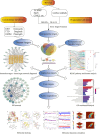Integrative UHPLC-HRMS and computational biology reveal ferroptosis and anoikis targeting by Wenpitongluo decoction in cardiorenal syndrome
- PMID: 40761388
- PMCID: PMC12319559
- DOI: 10.3389/fchem.2025.1617676
Integrative UHPLC-HRMS and computational biology reveal ferroptosis and anoikis targeting by Wenpitongluo decoction in cardiorenal syndrome
Abstract
Background: The Wenpitongluo Decoction (WPTLD) was a classical herbal formula composed of medicinal herbs with both edible and therapeutic properties. It demonstrated clinical efficacy in treating Cardiorenal Syndrome (CRS), though its mechanism of action remained unclear. Although inflammatory and oxidative stress pathways in CRS have been intensively studied, the roles of ferroptosis and anoikis, which may be activated by these pathways, have received little attention.
Methods: First, the active components of WPTLD were obtained through the TCMSP and Herb databases, and then identified using UHPLC-HRMS. Subsequently, target prediction of the identified components was carried out via the SwissTargetPrediction platform. While CRS-related targets were retrieved from GEO, GeneCards, and PharmGKB. A gene library of ferroptosis- and anoikis-associated targets was established. Tissue-specific mRNA expression profiles were analyzed via BioGPS. Subsequently, protein-protein interaction (PPI) networks were constructed to identify core targets, followed by Gene Ontology (GO) and Kyoto Encyclopedia of Genes and Genomes (KEGG) enrichment analyses using Metascape. Finally, molecular docking assessed binding affinities between active components and core targets, with top-ranked complexes undergoing molecular dynamics (MD) simulations.
Results: Fifteen bioactive components and 39 component-disease interaction targets were identified, predominantly localized in kidney, thymus, lung, adipocytes, adrenal gland, and heart tissues. Topological analysis of PPI networks revealed eight core targets, including ferroptosis-/anoikis-associated SIRT1, PTGS2, and PRKCA. KEGG analysis highlighted critical pathways such as AMPK and PI3K-Akt signaling. Notably, molecular docking and MD simulations demonstrated stable binding between active compounds and core targets.
Conclusion: This study systematically deciphers WPTLD's anti-CRS mechanisms via targeting ferroptosis- and anoikis-related genes through multi-pathway modulation. These findings not only clarify the pathological roles of ferroptosis and anoikis in CRS but also provide a computational framework for developing therapeutic strategies.
Keywords: Wenpitongluo decoction; anoikis; cardiorenal syndrome; computational biology; ferroptosis; oxidative stress.
Copyright © 2025 Mao, Shi, Chen, Li, Zhang and Song.
Conflict of interest statement
The authors declare that the research was conducted in the absence of any commercial or financial relationships that could be construed as a potential conflict of interest.
Figures








Similar articles
-
Elucidating the Mechanism of Xiaoqinglong Decoction in Chronic Urticaria Treatment: An Integrated Approach of Network Pharmacology, Bioinformatics Analysis, Molecular Docking, and Molecular Dynamics Simulations.Curr Comput Aided Drug Des. 2025 Jul 16. doi: 10.2174/0115734099391401250701045509. Online ahead of print. Curr Comput Aided Drug Des. 2025. PMID: 40676786
-
Understanding mechanisms of Polygonatum sibiricum-derived exosome-like nanoparticles against breast cancer through an integrated metabolomics and network pharmacology analysis.Front Chem. 2025 Jun 6;13:1559758. doi: 10.3389/fchem.2025.1559758. eCollection 2025. Front Chem. 2025. PMID: 40547857 Free PMC article.
-
Mechanism of Salvia miltiorrhiza in the treatment of periodontitis: integrative analyses via network pharmacology, molecular dynamics, and cellular assays.BMC Complement Med Ther. 2025 Jul 28;25(1):291. doi: 10.1186/s12906-025-05040-4. BMC Complement Med Ther. 2025. PMID: 40721767 Free PMC article.
-
Medicine for chronic atrophic gastritis: a systematic review, meta- and network pharmacology analysis.Ann Med. 2023;55(2):2299352. doi: 10.1080/07853890.2023.2299352. Epub 2024 Jan 3. Ann Med. 2023. PMID: 38170849 Free PMC article.
-
Study on the mechanism of Shujin Tongluo granules in treating cervical spondylosis based on network pharmacology and molecular docking.Medicine (Baltimore). 2023 Jul 21;102(29):e34030. doi: 10.1097/MD.0000000000034030. Medicine (Baltimore). 2023. PMID: 37478234 Free PMC article.
References
-
- Abraham M. J., Murtola T., Schulz R., Páll S., Smith J. C., Hess B., et al. (2015). GROMACS: high performance molecular simulations through multi-level parallelism from laptops to supercomputers. SoftwareX 1–2, 19–25. 10.1016/j.softx.2015.06.001 - DOI
LinkOut - more resources
Full Text Sources
Research Materials
Miscellaneous

